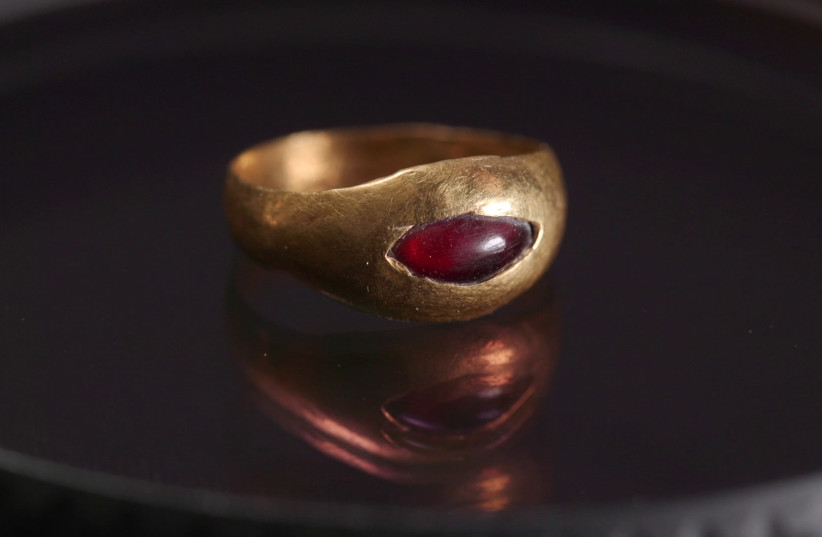Archaeologists in Jerusalem’s City of David were recently amazed and moved to uncover a rare, small gold ring set with a precious stone – apparently made for and worn by a little boy or girl who lived there during the Hellenistic period some 2,300 years ago.
The excavations were carried out jointly by the Israel Antiquities Authority (IAA) and Tel Aviv University (TAU) as part of the Jerusalem Walls National Park project, with the support of the Elad Foundation.
“It is an unusual and deeply moving find; not one that we discover every day,” the archaeological team said.
The red precious stone was apparently a garnet, and the gold is a very refined material that was very well-preserved. Since its last use over two millennia ago, the ring hasn’t accumulated rust or suffered any other weathering of time.
An exciting discovery
This special ring was recently discovered by Tehiya Gangate, a City of David excavation team member. While she was sifting earth through a screen, she suddenly saw something glitter. “I immediately yelled, ‘I found a ring, I found a ring!’ Within seconds, everyone gathered around me, and there was great excitement. This is an emotionally moving find. I always wanted to find gold jewelry, and I am very happy this dream came true – literally a week before I went on maternity leave,” she said.
IAA excavation directors Dr. Yiftah Shalev and Riki Zalut Har-tov said, “The ring is very small. It might fit a woman’s pinkie or a young girl's or boy’s finger.”
Dr. Marion Zindel added that the ring was created by hammering thin pre-cut gold leaves on a metal ring base. Stylistically, it reflects the common fashion of the Persian and Early Hellenistic periods, dating from the late Fourth to early Third-century BCE and onwards. In that period, people began to prefer gold with set stones rather than decorated gold.

TAU Prof. Yuval Gadot and excavator Efrat Bocher explained that the recently found gold ring joins other ornaments of the early Hellenistic period found in the City of David excavations, including a horned-animal earring and a decorated gold bead.
Gold jewelry was well-known in the Hellenistic world, from Alexander the Great’s reign onward. His conquests helped spread and transport luxury goods and products. Often jewelry decorations were inspired by mythological figures or significant symbolic events.
The Givati parking lot excavation finds are beginning to paint a new picture of the nature and stature of Jerusalem’s inhabitants in the Early Hellenistic period. In the past, researchers found only a few structures and finds from this era so most scholars assumed that Jerusalem was then a small town limited to the top of the southeastern slope (the City of David), and with relatively very few resources. However, these new findings suggest a different story, Gadot and Bocher added.
They revealed that the structures being unearthed now consist of an entire neighborhood.
“This attests to both domestic and public buildings and shows that the city extended from the hilltop westward. The character of the buildings – and now the gold finds and other discoveries – display the city’s healthy economy and even its elite status. It certainly seems that the city’s residents were open to the widespread Hellenistic style and influences prevalent also in the eastern Mediterranean Basin,” they continued.
IAA director Eli Escuzido concluded that “the excavation in ancient Jerusalem reveals invaluable information to us about our past. In honor of Jerusalem Day, we are inviting the public to attend, free of charge, an evening dedicated to fascinating discoveries in Jerusalem. Details can be found on the Israel Antiquities Authority website.”
The ring will be put on public view for the first time at the Jerusalem Day conference called, Jerusalem Mysteries – the Archaeology of Jerusalem. The conference will be held on June 5 in the IAA’s Jay and Jeanie Schottenstein National Campus for the Archaeology of Israel near the Israel Museum.
https://www.antiquities.org.il/default_en.aspx
